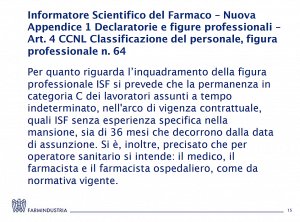
Interview with two representatives of workers in the sector: Sergio Cardinali (Filctem-Cgil) and Gianluca Bianco (Femca-Cisl). The trend is positive - they say - but there is more to be done in terms of training and the reduction of scientific representatives is becoming increasingly problematic and requires a timely solution (From issue 153 of AboutPharma)
All is not well, Madame la Marchioness. While the preparatory work for the renewal of the national chemical-pharmaceutical contract begins and the new Stability law is being approved, the pharmaceutical sector unions recognize the good state of health of the sector. But they also underline the presence of problematic aspects that must be resolved as soon as possible. Starting with employment crisis of some professional figures such as scientific representatives (50% less in the last ten years) and by the need to invest more and better in the training of the employed in order not to be displaced by the disruption of the fourth industrial revolution. The point of view, with the natural differences in priority and sensitivity, is that of two exponents of the most representative acronyms of the sector: Sergio Cardinali, of the national pharmaceutical chemical department of Filctem-Cgil, and Gianluca Bianco, national secretary Femca-Cisl.
The pact for innovation and employability signed by Farmindustria, Federchimica and the trade unions of the pharmaceutical and chemical sector
 An opportunity to reflect on the lights and shadows of the sector comes from the pact to promote innovation, productivity, employability and social responsibility signed in October by Farmindustria, Federchimica, Filctem-Cgil, Femca-Cisl and Uiltec-Uil. The agreement was stipulated in view of the opening of negotiations for the renewals of the collective bargaining agreement, which will start, according to forecasts, in the summer of 2018. Both the trade associations and the pharmaceutical sector unions confirm their full willingness to dialogue and by comparison. On the other hand, in the sector, industrial relations have always been characterized by low levels of conflict and a climate of reciprocal collaboration.
An opportunity to reflect on the lights and shadows of the sector comes from the pact to promote innovation, productivity, employability and social responsibility signed in October by Farmindustria, Federchimica, Filctem-Cgil, Femca-Cisl and Uiltec-Uil. The agreement was stipulated in view of the opening of negotiations for the renewals of the collective bargaining agreement, which will start, according to forecasts, in the summer of 2018. Both the trade associations and the pharmaceutical sector unions confirm their full willingness to dialogue and by comparison. On the other hand, in the sector, industrial relations have always been characterized by low levels of conflict and a climate of reciprocal collaboration.
Scaccabarozzi (Farmindustria): "Human resources an attractive factor, we want to invest"
“The quality of human resources is the first factor of attraction for our country – said Massimo Scaccabarozzi, President of Farmindustria commenting on the pact – and is therefore fundamental for growth. This is why we want to continue to invest, in constant and proactive dialogue with the social partners – to relaunch our ability to contribute even more to Italy's economic recovery. Qualified employment, and for the most part 'pink', production, exports, investments in R&D and in factories in the area, welfare: all strengths of an industry that is a flagship of the country. And it wants to continue to be so by leveraging innovation and internationalisation”.
The strengths of the sector
The strengths of the pharmaceutical industry highlighted by Scaccabarozzi are confirmed by the numbers presented last June by Farmindustria. In 2016, production increased by 2.3% to 30 billion. Exports, which represent 71% of the sector, amount to 21 billion and, since 2010, have recorded an increase of 52%. The number of employed people grew by about six thousand units, reaching 64 thousand. If we also consider related industries, there are 228,000 employees in the sector overall. Investments in 2016 were 2.7 billion, with a surge of 20% in three years.
The data of the Italian "recovery".
At the same time, encouraging signals are coming from the entire country's economy. In August 2017, based on the most recent Istat data available, there was an increase in employed persons of 36,000 compared to July and of 375,000 compared to the same month last year. The employment rate rose to 58.2% (+1% compared to August 2016) and unemployment fell to 11.2%. Industrial production, driven precisely by pharmaceuticals, went up by 5.7% in August And confirming the evolution of industrial relations, not only in pharma, it can be noted that the number of second-level contracts - corporate and territorial - deposited it reached 25,658 (Ministry of Labor data - September 2017).
The possible measures of the next stability law
On the decisions front, the 2018 maneuver launched by the government, pending examination by Parliament, tends to reconfirm the measures that seem to have contributed the most to the "recovery" of recent months. For employment, for example, the flagship intervention is the three-year contribution relief to the 50% for hirings with increasing protection up to 29 years, with a limit of three thousand euros. The subsidy would be 100% for hiring in the southern regions and, regardless of age, for young people from apprenticeships and school/work alternation. In addition, for 2018 alone, it would also concern the new engagements of young people up to 35 years of age.
More incentives for Industry 4.0
As for the measures to increase investments and productivity, the incentives of Industry 4.0 (super-depreciation, hyper-depreciation, tax credit for training 4.0) should be extended, although probably with some downward adjustments. In short, the scenario looks rather rosy. But, as mentioned, the unions in the pharmaceutical sector, represented in this case by Cardinali and Bianco, maintain that not everything is perfect.
The interview/How is the Italian pharma industry according to the pharmaceutical trade unions? Are there gray areas regarding employment?
(Sergio Cardinali replies) Certainly, given the numbers, there are many lights, especially as regards production. But the shadows are not lacking, and they are not insignificant. For example, there is an issue common to all sectors: the declining retirement age. There are many workers who are getting older and are confronted with a hi-tech and highly innovative industry, risking not keeping up. Systems should be found to facilitate the exit of those who are older: slides, part-time without losing wage levels, forms of juxtaposition between young and old. Since there are no legislative instruments to deal with this situation in economic terms, we will address this issue during the negotiations on the next contract renewal, seeking solutions between the union and the industry.
Then there is the big problem of scientific information. Many ISFs, especially older people, are made redundant through collective or individual redundancy procedures. And in their place, younger personnel are hired, perhaps through subsidiary companies: according to our calculations, for every ten redundant people who leave, there are at least six hires made in different ways. In addition, people employed with a chemical-pharmaceutical contract are let out and others enter with an agent contract  Enasarco trade. It is not acceptable. And in our opinion it clashes with the law. Finally, there is the problem of research. Although the sector invests more in R&D than others, several research centers run by companies have closed in recent years. This has led to a contraction of employment in this area and there has been no action to remedy it.
Enasarco trade. It is not acceptable. And in our opinion it clashes with the law. Finally, there is the problem of research. Although the sector invests more in R&D than others, several research centers run by companies have closed in recent years. This has led to a contraction of employment in this area and there has been no action to remedy it.
(Gianluca Bianco replies – on the left in the photo) The data speak for themselves: growing exports, 15% of investments in R&D, second place for production, increasing employment. The sector is undoubtedly in good health. But a solution must be found to the issue of scientific representatives: in the last ten years there has been a reduction of the 50%. It's true: with many drugs genericized, traditional FSI is less needed by doctors and patients. But the profession of informant has great value, above all for the protection of citizens' health. So we need to intervene on training to make these professionals even more qualified and in step with innovations.
What are the most significant ongoing disputes? Are there any emergency situations?
(SC) At the moment, thehe most demanding dispute is that relating to Alfasigma, engaged in a reorganization following the merger between Alfawassermann, Sigma-Tau and Biofutura. (The company announced 358 redundancies and 87 headquarters transfers but in the early days it was called ahypothetical agreement for which the redundancies go from 456 to 300 and voluntary exit plans are prepared, ed.). Also in this case, the figure that catches the eye is the involvement of 274 ISFs, who are the ones who pay the most. In addition, in a period in which there is talk of computerization, circulation of work on networks, Industry 4.0, it is especially noteworthy that dozens of workers are still moving from one city to another. It is a choice that goes against the trend.
(GB) This year the disputes are almost exclusively in the context of reorganisations. But there have been no very heavy renovations. The only case is Alfasigma. All in all, however, the company's project, beyond the high number of redundancies, can be an opportunity for the sector and, among other things, for Italian ownership. The company took on a very demanding operation: the situation of Sigma-Tau was very critical. While in this perspective it regains momentum. And a production site like the one in Pomezia can come out of it well.
At what stage is second-level bargaining in the sector and what kind of results is it producing?
(SC) Bargaining in the pharma sector is substantially positive. The second level is widely used in almost all companies. In fact, however, we are looking for a very flexible type of company contract, which allows us to cover fluctuations in production when certain drugs lose their patent protection and genericization is triggered. When there are no new medicines that can replace the income of the old ones, companies ask for flexible tools to be able to act on the cost of labour. If, on the other hand, they produce innovative drugs capable of generating returns, the high turnover often turns into dividends for shareholders.
As for corporate welfare, good results have also been achieved through second-level bargaining. However, there is one critical point that should not be forgotten. As long as the tax relief is in effect for the decision to transform the resources of the bonuses into benefits included in the corporate welfare, the system works well. But if tomorrow, beyond the reassurances coming from politics, the tax relief were to cease, even the effectiveness of the instrument would be called into question.
(GB) There is a lot of corporate bargaining: approximately, in the pharmaceutical sector, it reaches 90%. On the other hand, ours is a sector where worker participation in company life is good. And even the corporate observatories foreseen by the national contract have been implemented much better by pharma. They are internal company tools in which workers can obtain information and deal with crucial issues, from work organization to training. All the major groups present in Italy have activated it. It is a different, “Italian-style” model of participation  from the German one, but still with interesting elements and perspectives.
from the German one, but still with interesting elements and perspectives.
How are industrial relations at the moment between companies and trade unions in the pharmaceutical sector?
(SC) This sector has always had a culture in which industrial relations have an important role. There is little conflict. If it comes to agitation, it is for truly critical cases. Then, obviously, a better use of some tools can also arise from these good relationships. For example, the joint company-union observers are aimed, among other things, at getting to know the national collective labor agreement better. Fine, but in addition to dealing with contractual issues, why don't we use them to think deeply about the evolution of work and the importance of training?
(GB) I introduce the answer with a joke I once heard in the Ministry of Labour. They said to me: “but we never see you in the chemist-pharmaceutical department here”. Proof that we almost always resolve issues through solid industrial relations. We know how to manage both positive and negative phases. Work has now begun for the renewal of the national contract, the negotiations for which will open next summer. There are items on the agenda. For example, one that could further improve relations could be to reactivate the National Contractual Observatory of the pharmaceutical sector in which to address the problems in the field. Now we have one for the whole contract: we would need a specific one again for pharma.
What is your opinion on the industrial policy of the last few years for the sector and on what is taking shape with the next Stability law?
(SC) Let's take, for example, a topic that is much discussed: Industry 4.0. I'm not convinced by all these concessions only on the purchase of new machinery. If a company renews its technological park and the investment does not envisage a connection with employment, there is the risk that the increase in automation will correspond to a reduction in the number of employed persons. Since these investments are supported by taxpayers' money it is only right that a positive return on employment is guaranteed. Otherwise there is a risk of not increasing the number of employees and of giving resources to multinationals which then bring dividends abroad: something must remain in the country if the money is public.
One could envisage, for example, that a part of the resources that companies save could be destined for outgoing investments – therefore slides – for older workers and more hiring of young people. Among other things, it would also be convenient because younger staff cost less and are more productive. In this sense, if the government intervened decisively on pensions and introduced measures to facilitate this generational turnover, it would be a positive thing.
(GB) As far as work is concerned, some positive effects have been seen. But there is more to be done on industrial policies: the possible confirmation of investment incentives and all Industry 4.0 interventions are not the solution to all problems. We still need to affect the regulatory system, training, energy, infrastructure. Regulatory uncertainty creates great uncertainty in all sectors, including pharma. We need to work to facilitate the entry of new medicines into the market, especially innovative ones, which are very expensive. On this issue, we are in line with the requests of companies: only in the presence of strong, healthy and productive companies can well-being be restored to workers and citizens.
As for Industry 4.0, so far we have no news of reorganizations that have produced negative effects on employment levels. We are trying to understand the phenomenon. Without a doubt there are many operations that can be replaced by machines managed through digital technologies. And this will pose some problems, especially if it does not increase the professionalism of the operators. This is why training assumes an even more strategic role. In any case, all revolutions have led to major changes in the workplace. But they also brought new and more professionalized jobs as well. It's about accepting challenges, provided you have the tools to manage them.
According to the pharmaceutical sector unions, is Italy capable of attracting investments in this sector? Is it possible to bring a significant share of the production of pharma multinationals to the country?
(SC) At present, I would be tempted to say yes. The country is still attractive above all for the potential of skilled labor it has and for the high productivity it manages to express at an industrial level. In addition, another element that continues to favor Italy is the good relationship that exists between the world of research in universities and companies. When it does not translate into cases of corruption, it is a high-value resource that can also be spent abroad. Of course, there are some critical issues in the country system that cannot be ignored. One is represented by the cost of labour, which remains among the highest in Europe. Naturally I am referring to taxation and not to wages, which are among the lowest compared to our countries. Then, another downside is the cost of energy. Pharma is an industry that has high energy consumption.
(GB) Italy remains a production hub at European and global level. And in recent years there has been a return of production in our country that had previously been relocated to EU or non-EU markets. We are getting competitive again. There have been dark years, during the crisis, in which we have witnessed heavy restructuring. Just think of the 50% of the isf workforce that we have lost along the way and of the various research centers that have been closed, such as that of Gsk in Verona or that of Merck & co in Pomezia. But now those years are behind us and there is a phase of consolidation in the sector. We return to invest here. I am thinking, for example, of the 35 million investment that the German Merck recently made in the Modugno plant, of the investments made in recent years by companies such as Eli Lilly and Janssen, of the Alfasigma operation itself, which is also Italian .
Training is the leitmotif to keep competitiveness high and prevent innovation from damaging employment. Where are we? Is what is foreseen in the national collective labor agreement to enhance it put into practice?
 (SC) There is very high attention towards the theme. The limit is that at the moment training is too much the prerogative of companies' choices. They decide how much to do, who to do it to, where and how. The idea of the delegate for training, envisaged by the collective bargaining agreement, was born precisely to involve workers more in the analysis of training needs. However, it is a tool that is not working very well, because it is little valued at company level and because - it must be admitted - even the workers themselves do not fully understand how important training is.
(SC) There is very high attention towards the theme. The limit is that at the moment training is too much the prerogative of companies' choices. They decide how much to do, who to do it to, where and how. The idea of the delegate for training, envisaged by the collective bargaining agreement, was born precisely to involve workers more in the analysis of training needs. However, it is a tool that is not working very well, because it is little valued at company level and because - it must be admitted - even the workers themselves do not fully understand how important training is.
(GB) Training is essential to help the professionals most in difficulty and to accompany the great changes of these times. I go back to the isf. I believe that the strong specialization of a series of innovative products that are landing on the market will undoubtedly push the informants towards an even higher quality of work. And again, we need to push training in the field of biotech, which is booming. Honestly, training must become an integral part of the work, not an extra part. Otherwise, the train of innovation will be lost.
In the area of training and retraining, there is a need to relaunch the instrumentation in support of active policies, still in progress through Welfarma, the only example of shared management of retraining and professional outplacement processes in the contractual landscape. Welfarma, built in 2008 and re-discussed in 2011, needs to be remodeled in the light of the new regulations, with respect to the training processes of requalification and costs.
Related news: The pharmaceutical unions: "We need training and opportunities for the ISFs"






